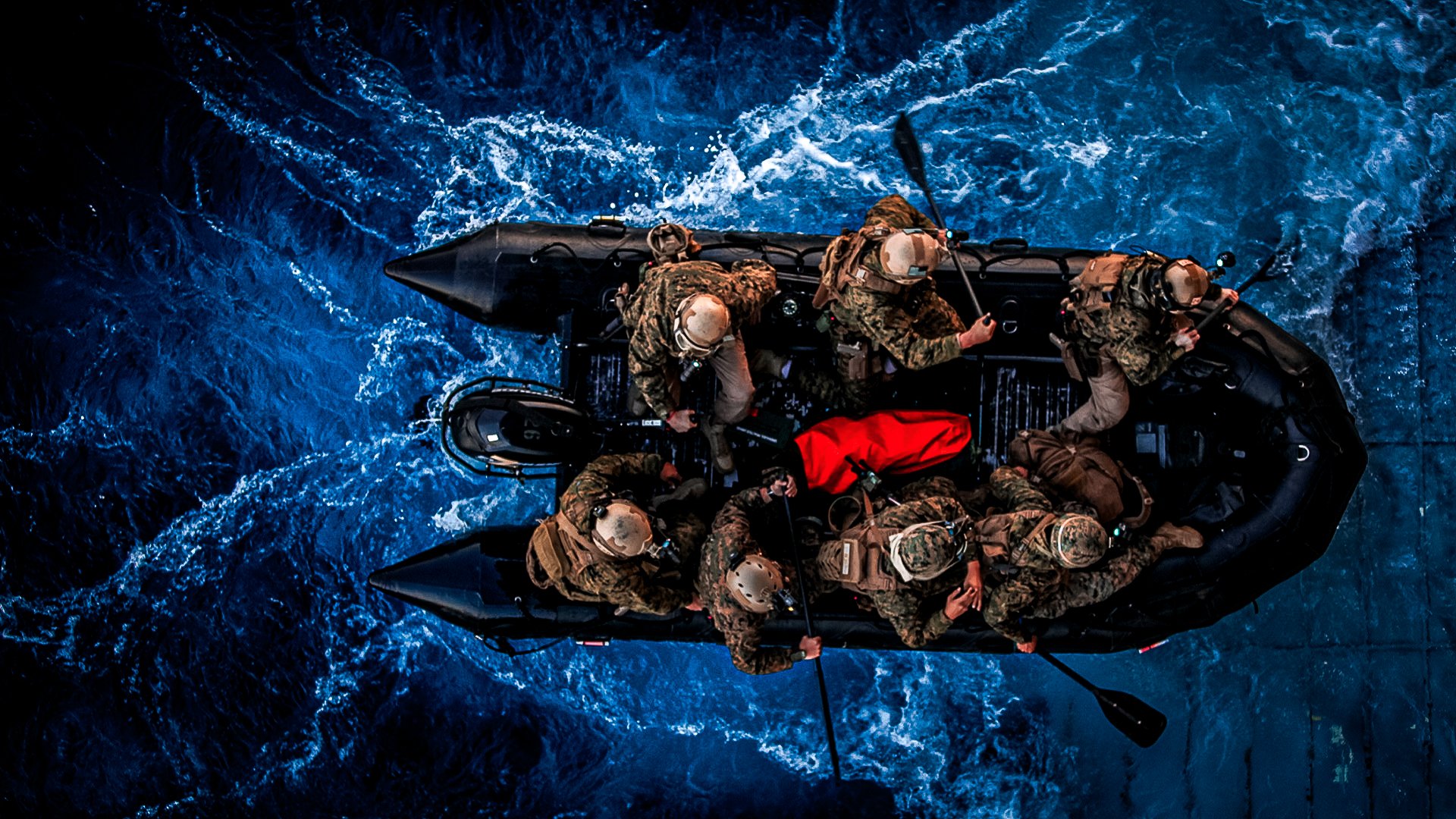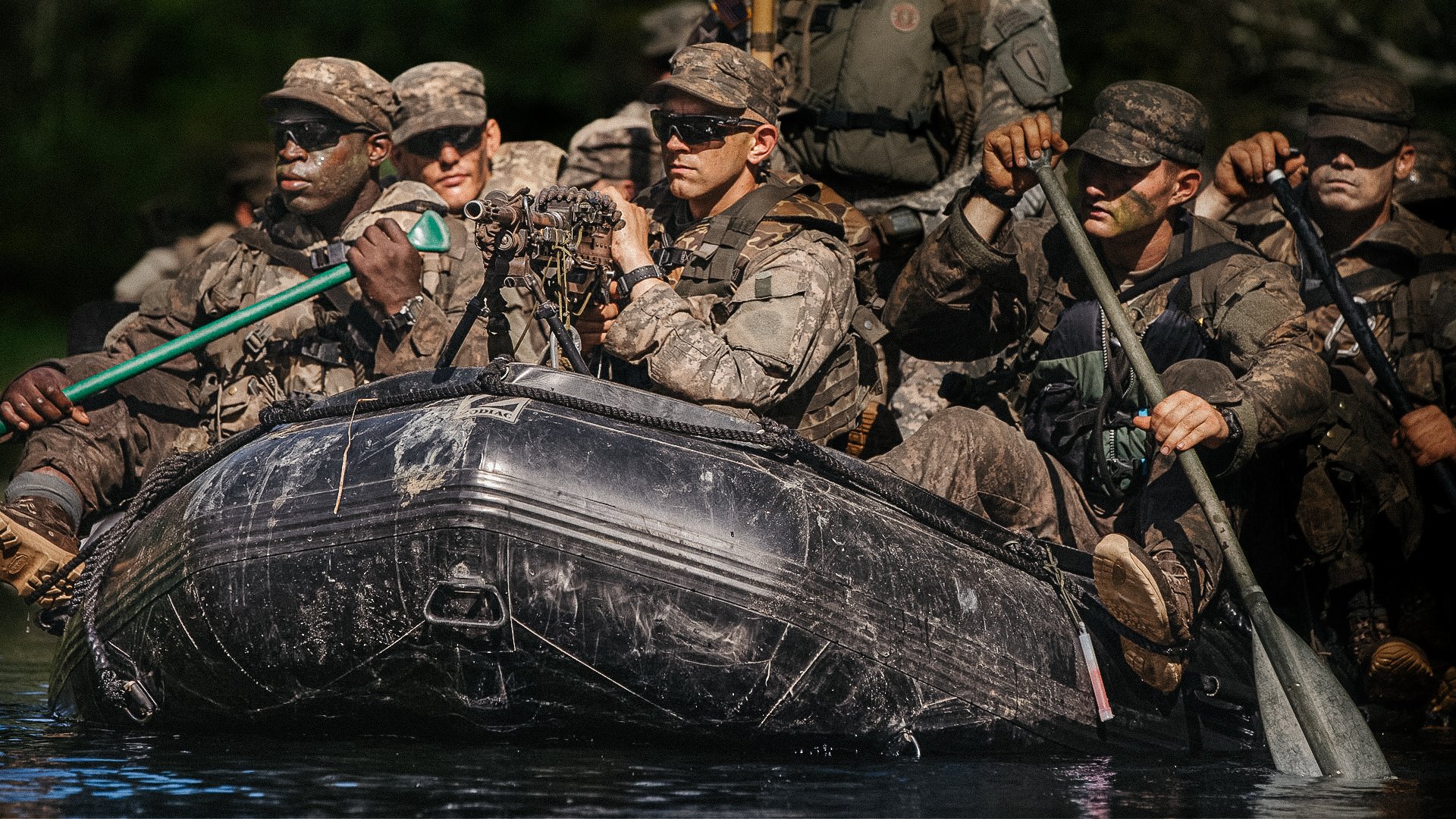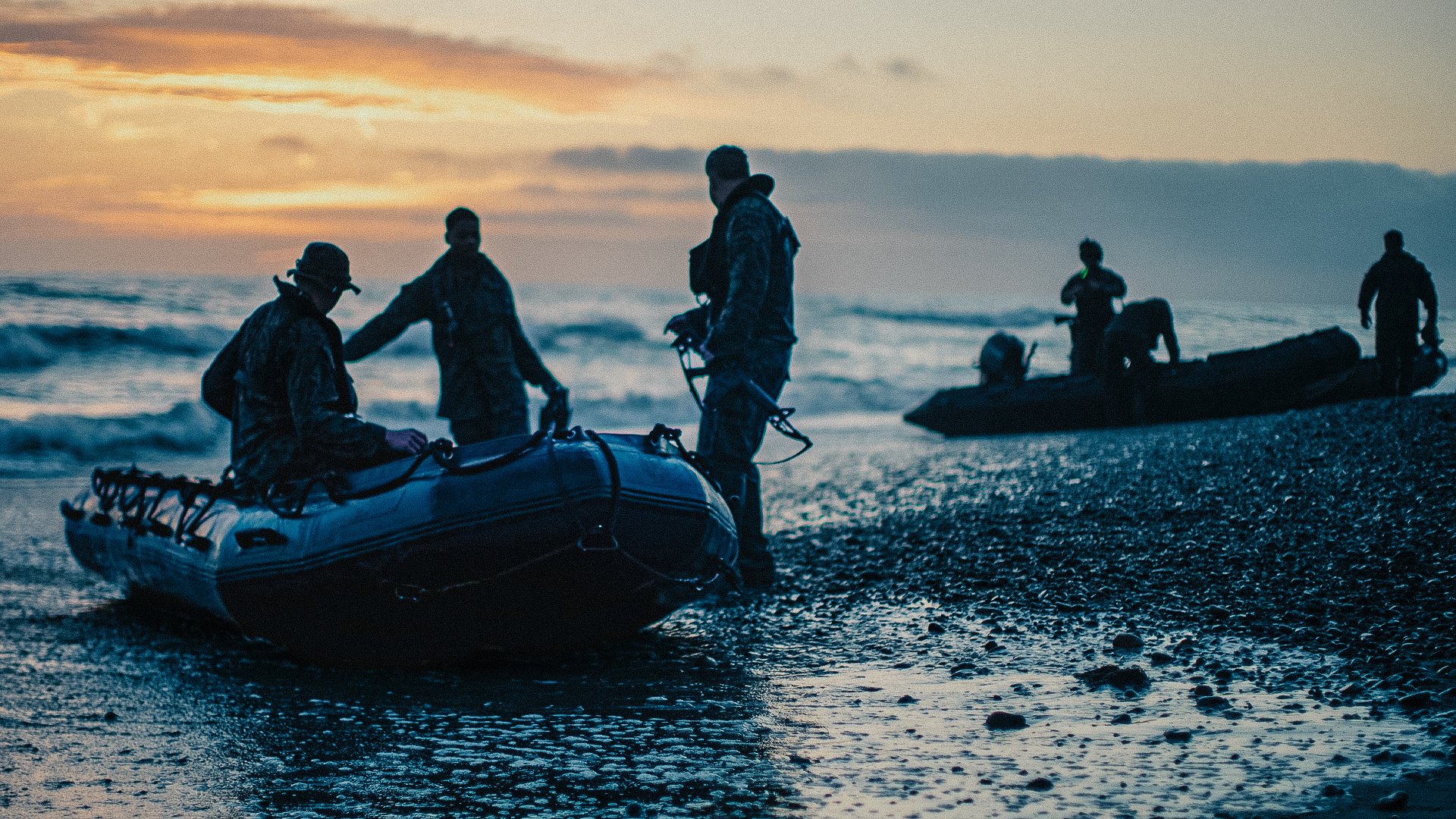
Marines with the All Domain Reconnaissance Detachment, 11th Marine Expeditionary Unit, carry a combat rubber raiding craft to launch from the well deck of amphibious dock landing ship USS Pearl Harbor (LSD 52) during a training operation, April 13, 2021. US Marine Corps photo by Cpl. Jaxson Fryar.
They are in every Navy SEAL recruiting commercial — sleek, black, low-profile boats, silently gliding across moonlit water, commandos with painted faces straddling the sides. Zodiac inflatable boats are emblematic of American special operations. Since before World War II, soldiers, sailors, and Marines have relied on the small, sturdy vessels to conduct clandestine operations along enemy coastlines. But the times have changed. Now, in a world where handheld drones, unmanned submersibles, and night vision make covert waterborne operations nearly impossible, are Zodiac boats obsolete?
Related: What It Means to Be a Navy SEAL, According to 5 SEALs
The Original Inflatable Boat
In 1776, George Washington’s Army boarded flat-bottomed Durham boats and traversed the icy Delaware to kill Hessians. Since then, the United States military has depended on small boats to carry out amphibious operations. For many years, they were made of wood. In 1938, a young Army lieutenant persuaded Uncle Sam to start making them out of inflatable rubber.

Marines with the 15th Marine Expeditionary Unit’s Maritime Raid Force depart the USS Essex (LHD 2) on a combat rubber raiding craft during Amphibious Squadron Three/Marine Expeditionary Unit Integration Training (PMINT) off the coast of San Diego March 4, 2015. US Marine Corps photo by Cpl. Elize McKelvey.
The young lieutenant’s name was Lloyd Peddicord. He belonged to the infamous Observer Group, a predecessor of Naval Special Warfare, Marine Reconnaissance, and Army Special Forces. At the onset of WWII, Peddicord designed a small inflatable boat intended to be used for amphibious reconnaissance. His creation was dubbed Landing Craft Rubber Small (LCRS).
Peddicord successfully pitched his prototype to the US War Department as well as the Goodyear Tire and Rubber Company, which manufactured the boats for the military until 1945. The LCRS proved a crucial asset for Marine Raiders and Navy Underwater Demolition Teams in the Pacific theater, where it was used for quietly operating in enemy-controlled waterways.
Related: Marine Raiders: The Corps’ Only Special Operations Unit
Zodiac Boats Today
The nature of amphibious warfare has changed drastically since Marines and sailors were sneaking ashore Japanese-held islands. Surveillance technology has also undergone significant advancements. Yet the LCRS has barely evolved from Peddicord’s original design. For that reason, the US military no longer uses that specific model.

Naval Special Warfare Operators (SEALs) and NATO special operations forces partners land a combatant rubber raiding craft (CRRC) aboard Ohio-class guided-missile submarine USS Florida (SSGN 728) during a special operations forces interoperability exercise, Feb. 27, 2023. US Navy photo by Mass Communications Specialist 2nd Class Matthew Dickinson.
Today, instead, American warfighters use the Combat Rubber Raiding Craft (CRRC), an upgraded version of the LCRS manufactured by Zodiac Nautic. Like its predecessor, the CRRC — sometimes called the Combat Rubber Reconnaissance Craft and colloquially referred to as the Zodiac — is a small, inflatable boat used primarily for reconnaissance and amphibious assaults.
The 15-foot Zodiac is composed of eight airtight chambers, which make the boat exceptionally buoyant for its relatively small size. This lends to the Zodiac’s reliability as an over-the-horizon craft. Crewmembers can disembark from larger ships hidden beyond the curvature of the Earth and use the smaller, less detectable Zodiac to reach their objective. Furthermore, its eight chambers can be inflated with a foot pump rather than a noisy electric or gas-powered pump, while collapsible aluminum deck plates help stabilize the otherwise entirely rubber boat and also provide a rigid enough platform to mount a 55-horsepower outboard engine.

Soldiers paddle a CRRC during Swamp Phase of Ranger School. Photo courtesy of Wikimedia Commons.
Despite the technological advancements that have made covert operations increasingly challenging, the upgraded Zodiacs are stealthy enough to still be used for inserting troops on enemy shores or vessels. The boat’s low profile and lack of a metal hull make it virtually undetectable to radar. Some models are even bulletproof. Their detachable armor plating, dubbed Armorflate, can effectively stop 7.62mm rounds from penetrating the boat’s rubber gunwales.

Marines with the All Domain Reconnaissance Detachment, 11th Marine Expeditionary Unit, load into combat rubber raiding craft during amphibious assault training at Marine Corps Base Camp Pendleton, California, April 7, 2021. US Marine Corps photo by Cpl. Seth Rosenberg.
Between the LCRS and the CRRC, the American Armed Forces have made use of Zodiac boats for nearly a century. And in future conflicts, they might prove even more useful. For example, many military strategists expect that in a war between the US and China, contested waterways would be a major point of friction. In that scenario, boats that are capable of rapidly and covertly deploying small teams of warfighters would be invaluable.
Read Next: Don’t Give Up the Ship: Why the Navy’s Mantra Really Belongs to the Marines

Mac Caltrider is a senior staff writer for Coffee or Die Magazine. He served in the US Marine Corps and is a former police officer. Caltrider earned his bachelor’s degree in history and now reads anything he can get his hands on. He is also the creator of Pipes & Pages, a site intended to increase readership among enlisted troops. Caltrider spends most of his time reading, writing, and waging a one-man war against premature hair loss.
BRCC and Bad Moon Print Press team up for an exclusive, limited-edition T-shirt design!
BRCC partners with Team Room Design for an exclusive T-shirt release!
Thirty Seconds Out has partnered with BRCC for an exclusive shirt design invoking the God of Winter.
Lucas O'Hara of Grizzly Forge has teamed up with BRCC for a badass, exclusive Shirt Club T-shirt design featuring his most popular knife and tiomahawk.
Coffee or Die sits down with one of the graphic designers behind Black Rifle Coffee's signature look and vibe.
Biden will award the Medal of Honor to a Vietnam War Army helicopter pilot who risked his life to save a reconnaissance team from almost certain death.
Ever wonder how much Jack Mandaville would f*ck sh*t up if he went back in time? The American Revolution didn't even see him coming.
A nearly 200-year-old West Point time capsule that at first appeared to yield little more than dust contains hidden treasure, the US Military Academy said.












